Male Breast: A Review of the Literature and Current State of the Art of Diagnostic Imaging Work-Up
Abstract
1. Introduction
2. Male Breast Development
3. Male Breast Disorders
3.1. Benign Breast Disease
3.2. Malignant Breast Disease
4. High-Risk Screening
5. Follow-Up
6. Transgender Individuals, Breast Cancer and Screening
7. Discussion
8. Conclusions
9. Future Directions
Funding
Institutional Review Board Statement
Informed Consent Statement
Data Availability Statement
Conflicts of Interest
References
- Korde, L.A.; Zujewski, J.A.; Kamin, L.; Giordano, S.; Domchek, S.; Anderson, W.F.; Bartlett, J.M.; Gelmon, K.; Nahleh, Z.; Bergh, J.; et al. Multidisciplinary meeting on male breast cancer: Summary and research recommendations. J. Clin. Oncol. 2010, 28, 2114–2122. [Google Scholar] [CrossRef] [PubMed]
- Yu, X.F.; Yang, H.J.; Yu, Y.; Zou, D.H.; Coleman, W.B. A prognostic analysis of male breast cancer (MBC) compared with post-menopausal female breast cancer (FBC). PLoS ONE 2015, 10, e0136670. [Google Scholar] [CrossRef] [PubMed]
- Gucalp, A.; Traina, T.A.; Eisner, J.R.; Parker, J.S.; Selitsky, S.R.; Park, B.H.; Elias, A.D.; Baskin-Bey, E.S.; Cardoso, F. Male breast cancer: A disease distinct from female breast cancer. Breast Cancer Res. Treat. 2019, 173, 37–48. [Google Scholar] [CrossRef] [PubMed]
- Nguyen, C.; Kettler, M.D.; Swirsky, M.E.; Miller, V.I.; Scott, C.; Krause, R.; Hadro, J.A. Male breast disease: Pictorial review with radiologic-pathologic correlation. Radiographics 2013, 33, 763–779. [Google Scholar] [CrossRef] [PubMed]
- Viana, M.P.; Tucunduva, T.C.M.; Torres, U.S.; Aguillar, V.L.N.; Bresciani, B.H.; Shimizu, C.; Chala, L.F.; Barros, N.; Mello, G.G.N. Imaging of male breast disease: The good, the bad and the ugly—A pictorial review. Clin. Imaging 2020, 68, 45–56. [Google Scholar] [CrossRef] [PubMed]
- Siegel, R.L.; Miller, K.D.; Fuchs, H.E.; Jemal, A. Cancer statistics, 2022. CA Cancer J. Clin. 2022, 72, 7–33. [Google Scholar] [CrossRef] [PubMed]
- Yang, S.; Leng, Y.; Chau, C.M.; Ma, K.F.J.; Fung, W.Y.; Chan, R.L.S.; Yung, W.T.A.; Leong, P.W.; Li, O.C.A.; Wong, T. The ins and outs of male breast and anterior chest wall lesions from childhood to adulthood. Clin. Radiol. 2022, 77, 503–513. [Google Scholar] [CrossRef]
- Konduri, S.; Singh, M.; Bobustuc, G.; Rovin, R.; Kassam, A. Epidemiology of male breast cancer. Breast 2020, 54, 8–14. [Google Scholar] [CrossRef]
- Chesebro, A.L.; Rives, A.F.; Shaffer, F. Male Breast Disease: What the Radiologist Needs to Know. Curr. Probl. Diagn. Radiol. 2019, 48, 482–493. [Google Scholar] [CrossRef]
- Agarwal, P.; Kohli, G. Fibroadenoma in the male breast: Truth or Myth? Turk. J. Surg. 2016, 32, 208–211. [Google Scholar] [CrossRef]
- Morikawa, H.; Nobuoka, M.; Amitani, M.; Shimizu, T.; Ohno, K.; Ono, M.; Oba, T.; Ito, T.; Kanai, T.; Maeno, K.; et al. Fibroadenoma in a young male breast: A case report and review of the literature. Clin. Case Rep. 2021, 9, e05114. [Google Scholar] [CrossRef] [PubMed]
- Furtado, C.; Stankiewicz, A.; Klcova, J.; Khan, M.; Bajwa, S.; Isa, Z.M. Is Breast Imaging in Male Patients With Benign Lumps Necessary? A Retrospective Study to Assess Concordance Between Clinical Diagnosis and Imaging Findings. Eur. J. Breast Health 2023, 19, 304–310. [Google Scholar] [CrossRef] [PubMed]
- Appelbaum, A.H.; Gregory, B.; Evans, F.F.; Levy, K.R.; Amirkhan, R.H.; Schumpert, T.D. Mammographic Appearances of Male Breast Disease 1 Recipient of a Certificate of Merit award for a scien-tific exhibit at the 1997 RSNA scientific assembly. Radiographics 1999, 19, 559–568. [Google Scholar] [CrossRef] [PubMed]
- Safak, K. Mammography Findings of Male Breast Diseases. J. Breast Health 2015, 11, 106–110. [Google Scholar] [CrossRef] [PubMed][Green Version]
- Yitta, S.; Singer, C.I.; Toth, H.B.; Mercado, C.L. Sonographic Appearances of Benign and Malignant Male Breast Disease With Mammographic and Pathologic Correlation. J. Ultrasound Med. 2010, 29, 931–947. [Google Scholar] [CrossRef] [PubMed]
- Rong, X.; Zhu, Q.; Jia, W.; Ma, T.; Wang, X.; Guo, N.; Ji, H. Ultrasonographic assessment of male breast diseases. Breast J. 2018, 24, 599–605. [Google Scholar] [CrossRef] [PubMed]
- Ak, M.; Yurtsever, C.; Cakir, O.F.; Yurtsever, N. Epidermal inclusion cyst in male breast: How to differentiate from other male breast lesions. Radiol. Case Rep. 2022, 17, 3919–3922. [Google Scholar] [CrossRef] [PubMed]
- Taboada, J.L.; Stephens, T.W.; Krishnamurthy, S.; Brandt, K.R.; Whitman, G.J. The many faces of fat necrosis in the breast. Am. J. Roentgenol. 2009, 192, 815–825. [Google Scholar] [CrossRef]
- Guzik, P.; Gęca, T.; Topolewski, P.; Harpula, M.; Czekierdowski, A. Diabetic Mastopathy. Review of Diagnostic Methods and Therapeutic Options. Int. J. Environ. Res. Public Health 2021, 19, 448. [Google Scholar] [CrossRef]
- Yoshino, R.; Yoshida, N.; Ito, A.; Ujiie, N.; Nakatsubo, M.; Kamikokura, Y.; Kitada, M. Subareolar Breast Abscess in a Male: A Case Report. Cureus 2023, 15, e42623. [Google Scholar] [CrossRef]
- Kasales, C.J.; Han, B.; Smith, J.S.; Chetlen, A.L.; Kaneda, H.J.; Shereef, S. Nonpuerperal mastitis and subareolar abscess of the breast. Am. J. Roentgenol. 2014, 202, W133–W139. [Google Scholar] [CrossRef] [PubMed]
- Hudspeth, T.N.; Shin, K.; Babiera, G.V.; Krishnamurthy, S.; Woodtichartpreecha, P.; Karbasian, N.; Whitman, G.J. A Pictorial Review of Sonography of Intramammary Lymph Nodes: When to Care and What to Do About It. Ultrasound Q. 2019, 35, 74–78. [Google Scholar] [CrossRef] [PubMed]
- Owji, S.C.; Shroff, N.; Robinson, A.S.; Posleman Monetto, F.E. Pseudoangiomatous stromal hyperplasia in a healthy young adult male. Radiol. Case Rep. 2022, 17, 2919–2922. [Google Scholar] [CrossRef] [PubMed]
- Liu, N.; Johnson, K.J.; Ma, C.X. Male Breast Cancer: An Updated Surveillance, Epidemiology, and End Results Data Analysis. Clin. Breast Cancer 2018, 18, e997–e1002. [Google Scholar] [CrossRef] [PubMed]
- Greif, J.M.; Pezzi, C.M.; Klimberg, S.V.; Bailey, L.; Zuraek, M. Gender differences in breast cancer: Analysis of 13,000 breast cancers in men from the national cancer data base. Ann. Surg. Oncol. 2012, 19, 3199–3204. [Google Scholar] [CrossRef] [PubMed]
- Brain, F.; Williams, B.; Iredale, R.; France, L.; Gray, J. Psychological distress in men with breast cancer. J. Clin. Oncol. 2006, 24, 95–101. [Google Scholar] [CrossRef] [PubMed]
- Cardoso, F.; Bartlett, J.; Slaets, L.; van Deurzen, C.; van Leeuwen-Stok, E.; Porter, P.; Linderholm, B.; Hedenfalk, I.; Schröder, C.; Martens, J.; et al. Characterization of male breast cancer: Results of the EORTC 10085/TBCRC/BIG/NABCG International Male Breast Cancer Program. Ann. Oncol. 2018, 29, 405–417. [Google Scholar] [CrossRef]
- Önder, Ö.; Azizova, A.; Durhan, G.; Elibol, F.D.; Akpınar, M.G.; Demirkazık, F. Imaging findings and classification of the common and uncommon male breast diseases. Insights Imaging 2020, 11, 27. [Google Scholar] [CrossRef]
- Lattin, G.E.; Jesinger, R.A.; Mattu, R.; Glassman, L.M. From the radiologic pathology archives: Diseases of the male breast: Radiologic-pathologic correlation. Radiographics 2013, 33, 461–489. [Google Scholar] [CrossRef]
- Mathew, J.; Perkins, G.H.; Stephens, T.; Middleton, L.P.; Yang, W.T. Primary breast cancer in men: Clinical, imaging, and pathologic findings in 57 patients. Am. J. Roentgenol. 2008, 191, 1631–1639. [Google Scholar] [CrossRef]
- Günhan-Bilgen, I.; Bozkaya, H.; Üstün, E.E.; Memiş, A. Male Breast Disease: Clinical, Mammographic, and Ultrasonographic Features. Eur. J. Radiol. 2002, 43, 246–255. [Google Scholar] [CrossRef] [PubMed]
- Adibelli, Z.H.; Oztekin, O.; Gunhan-Bilgen, I.; Postaci, H.; Uslu, A.; Ilhan, E. Imaging characteristics of male breast disease. Breast J. 2010, 16, 510–518. [Google Scholar] [CrossRef] [PubMed]
- Giordano, S.H.; Cohen, D.S.; Buzdar, A.U.; Perkins, G.; Hortobagyi, G.N. Breast carcinoma in men: A population-based study. Cancer 2004, 101, 51–57. [Google Scholar] [CrossRef] [PubMed]
- Pal, S.K.; Lau, S.K.; Kruper, L.; Nwoye, U.; Garberoglio, C.; Gupta, R.K.; Paz, B.; Vora, L.; Guzman, E.; Artinyan, A.; et al. Papillary carcinoma of the breast: An overview. Breast Cancer Res. Treat. 2010, 122, 637–645. [Google Scholar] [CrossRef] [PubMed]
- Sinha, S.; Hughes, R.G.; Ryley, N.G. Papillary carcinoma in a male breast cyst: A diagnostic challenge. Ann. R. Coll. Surg. Engl. 2006, 88, 3–5. [Google Scholar] [CrossRef] [PubMed]
- Yang, W.S.; Whitman, G.J.; Yuen, E.H.Y.; Tse, G.M.K.; Stelling, C.B. Sonographic Features of Primary Breast Cancer in Men. Am. J. Roentgenol. 2001, 176, 413–416. [Google Scholar] [CrossRef] [PubMed]
- Goss, P.E.; Reid, C.; Pintilie, M.; Lim, R.; Miller, N. Male Breast Carcinoma A Review of 229 Patients Who Presented to the Princess Margaret Hospital during 40 Years: 1955-1996. Cancer 1999, 85, 629–639. [Google Scholar] [CrossRef]
- Gómez-Raposo, C.; Zambrana Tévar, F.; Sereno Moyano, M.; López Gómez, M.; Casado, E. Male breast cancer. Cancer Treat. Rev. 2010, 36, 451–457. [Google Scholar] [CrossRef]
- Albayrak, Z.K.; Önay, H.K.; Karataǧ, G.Y.; Karataǧ, O. Invasive lobular carcinoma of the breast: Mammographic and sonographic evaluation. Diagn. Interv. Radiol. 2011, 17, 232–238. [Google Scholar] [CrossRef]
- Burga, A.M.; Fadare, O.; Lininger, R.A.; Tavassoli, F.A. Invasive carcinomas of the male breast: A morphologic study of the distribution of histologic subtypes and metastatic patterns in 778 cases. Virchows Arch. 2006, 449, 507–512. [Google Scholar] [CrossRef]
- Nahleh, Z.A. Hormonal therapy for male breast cancer: A different approach for a different disease. Cancer Treat. Rev. 2006, 32, 101–105. [Google Scholar] [CrossRef] [PubMed]
- Niell, B.L.; Lourenco, A.P.; Moy, L.; Baron, P.; Didwania, A.D.; Diflorio-Alexander, R.M.; Heller, S.L.; Holbrook, A.I.; Le-Petross, H.T.; Lewin, A.A.; et al. ACR Appropriateness Criteria® Evaluation of the Symptomatic Male Breast. J. Am. Coll. Radiol. 2018, 15, S313–S320. [Google Scholar] [CrossRef] [PubMed]
- Myers, E.R.; Moorman, P.; Gierisch, J.M.; Havrilesky, L.J.; Grimm, L.J.; Ghate, S.; Davidson, B.; Mongtomery, R.C.; Crowley, M.J.; McCrory, D.C.; et al. Benefits and Harms of Breast Cancer Screening: A Systematic Review. JAMA 2015, 314, 1615–1634. [Google Scholar] [CrossRef] [PubMed]
- Daly, M.B.; Pal, T.; Berry, M.P.; Buys, S.S.; Dickson, P.; Domchek, S.M.; Elkhanany, A.; Friedman, S.; Goggins, M.; Hutton, M.L.; et al. Genetic/familial high-risk assessment: Breast, ovarian, and pancreatic, version 2.2021. J. Natl. Compr. Cancer Netw. 2021, 19, 77–102. [Google Scholar] [CrossRef] [PubMed]
- Hassett, M.J.; Somerfield, M.R.; Giordano, S.H.; Baker, E.R.; Cardoso, F.; Kansal, K.J.; Kwait, D.C.; Plichta, J.K.; Ricker, C.; Roshal, A.; et al. Management of Male Breast Cancer: ASCO Guideline. J. Clin. Oncol. 2020, 38, 1849–1863. [Google Scholar] [CrossRef] [PubMed]
- Stowell, J.T.; Grimstad, F.W.; Kirkpatrick, D.L.; Brown, E.R.; Santucci, R.A.; Crane, C.; Patel, A.K.; Phillips, J.; Ferreira, M.A.; Ferreira, F.R.; et al. Imaging Findings in Transgender Patients after Gender-affirming Surgery. Radiographics 2019, 39, 1368–1392. [Google Scholar] [CrossRef] [PubMed]
- Fabris, B.; Bernardi, S.; Trombetta, C. Cross-sex hormone therapy for gender dysphoria. J. Endocrinol. Investig. 2015, 38, 269–282. [Google Scholar] [CrossRef] [PubMed]
- Zhang, Q.; Goodman, M.; Adams, N.; Corneil, T.; Hashemi, L.; Kreukels, B.; Motmans, J.; Snyder, R.; Coleman, E. Epidemiological considerations in transgender health: A systematic review with focus on higher quality data. Int. J. Transgender Health 2020, 21, 125–137. [Google Scholar] [CrossRef]
- Leone, A.G.; Trapani, D.; Schabath, M.B.; Safer, J.D.; Scout, N.F.N.; Lambertini, M.; Berardi, R.; Marsoni, S.; Perrone, F.; Cinieri, S.; et al. Cancer in Transgender and Gender-Diverse Persons: A Review. JAMA Oncol. 2023, 9, 556–563. [Google Scholar] [CrossRef]
- Breast Cancer Screening and Diagnosis, Version 1.2022; NCCN: Plymouth Meeting, PA, USA, 2022.
- Linee Guida Neoplasie della Mammella. Available online: https://www.aiom.it/wp-content/uploads/2021/11/2021_LG_AIOM_Neoplasie_Mammella_11112021.pdf.pdf (accessed on 20 September 2023).
- Brown, A.; Lourenco, A.P.; Niell, B.L.; Cronin, B.; Dibble, E.H.; DiNome, M.L.; Tuscano, D.S.; Moy, L. ACR Appropriateness Criteria® Transgender Breast Cancer Screening. J. Am. Coll Radiol. 2021, 18, S502–S515. [Google Scholar] [CrossRef]
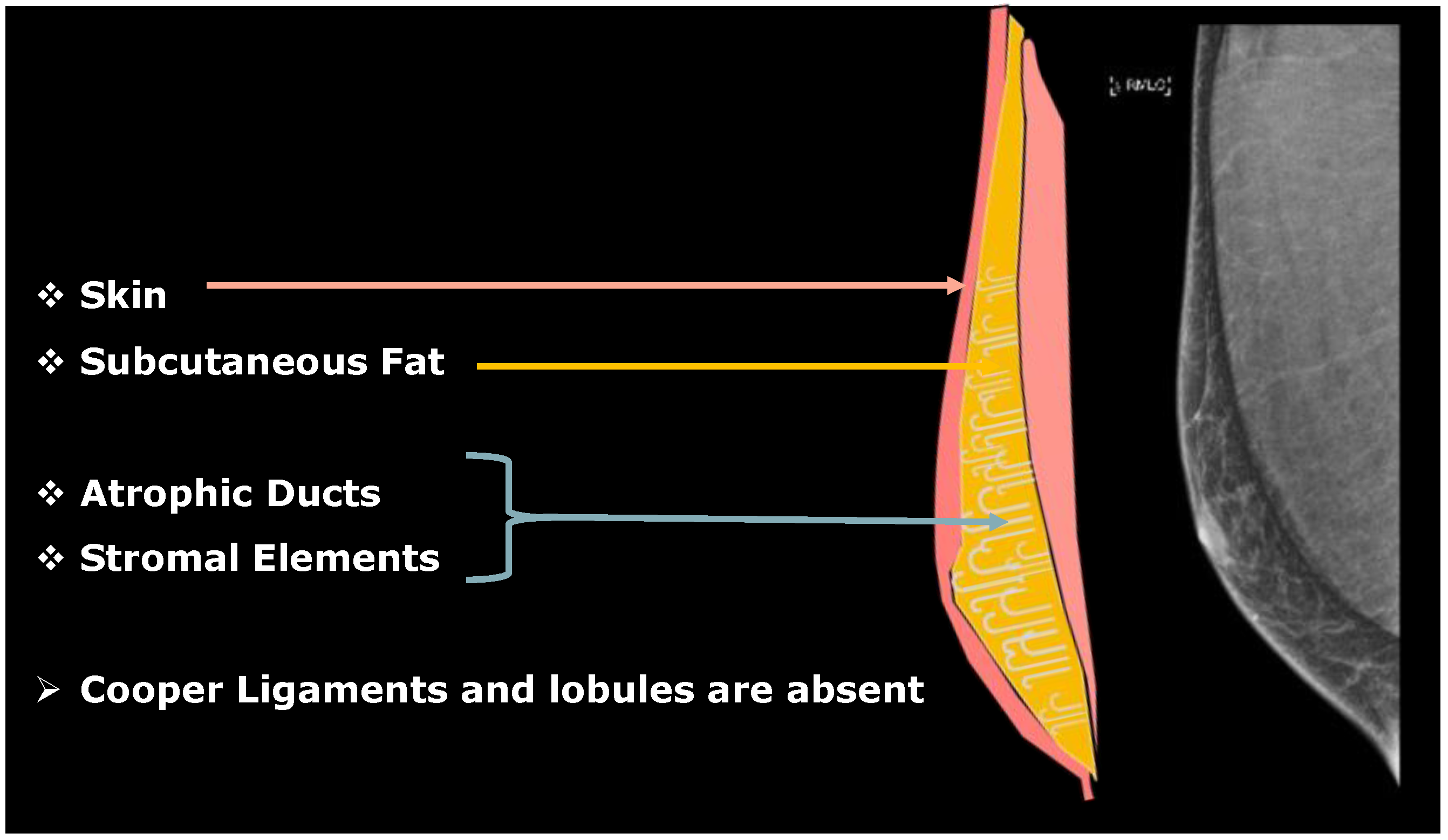
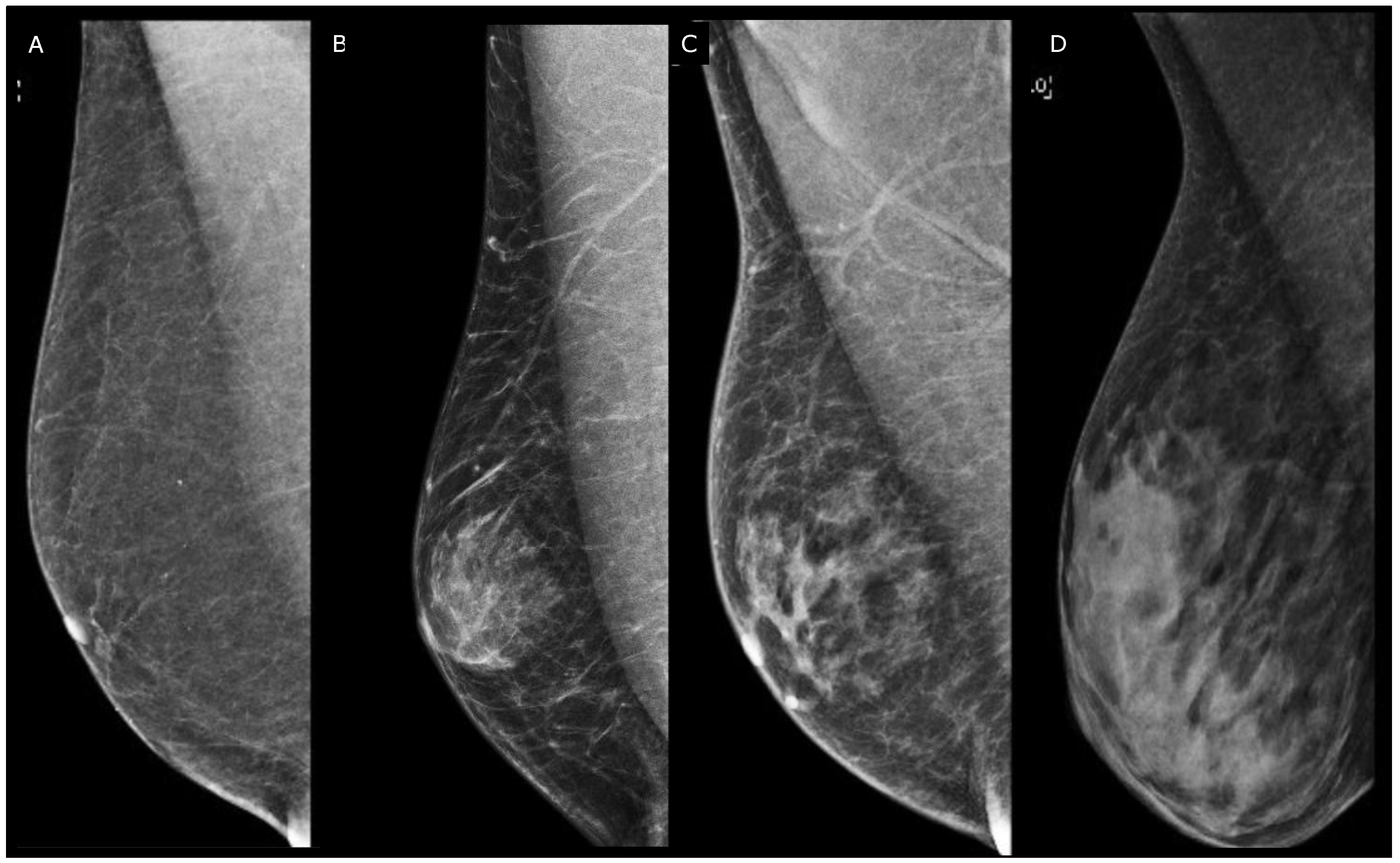
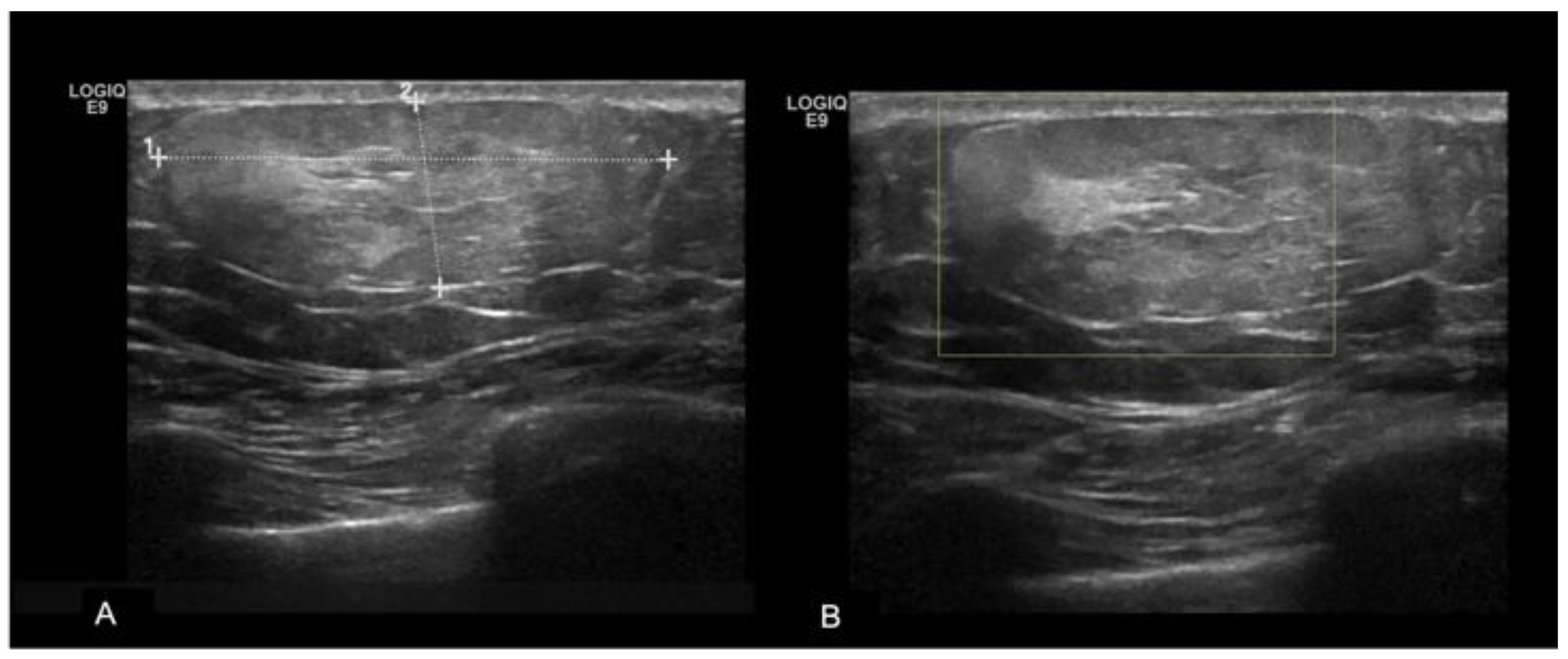
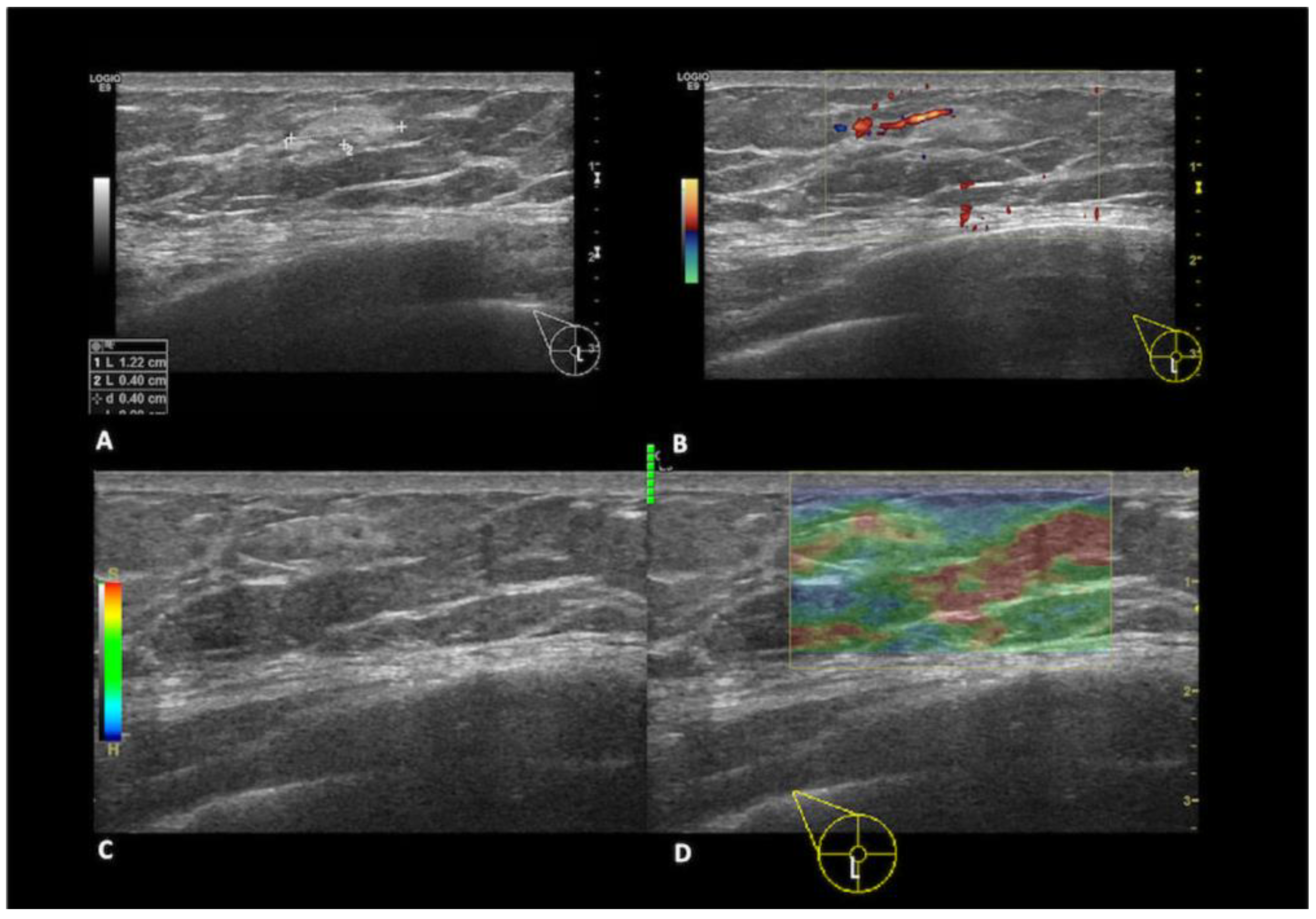
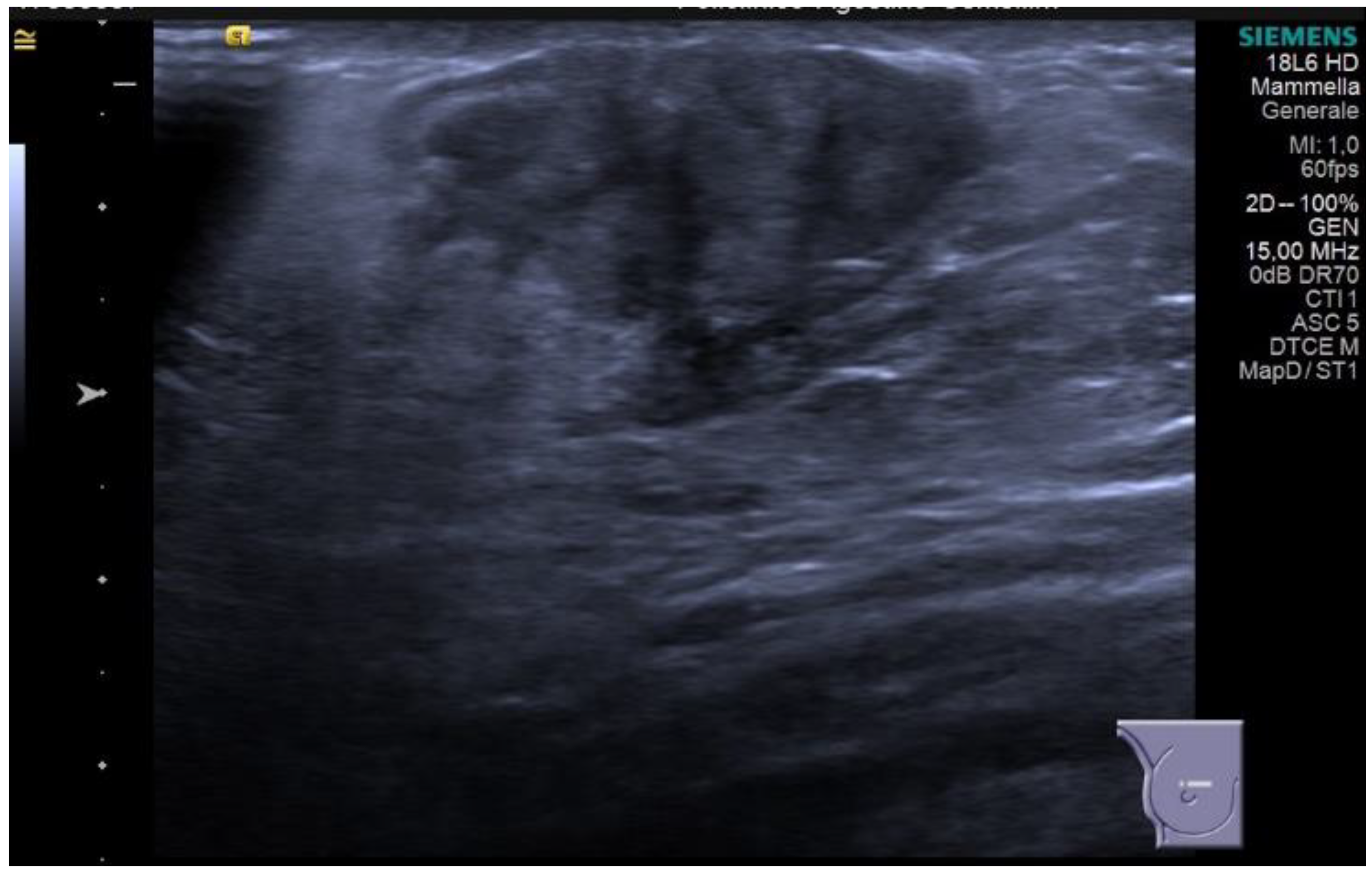

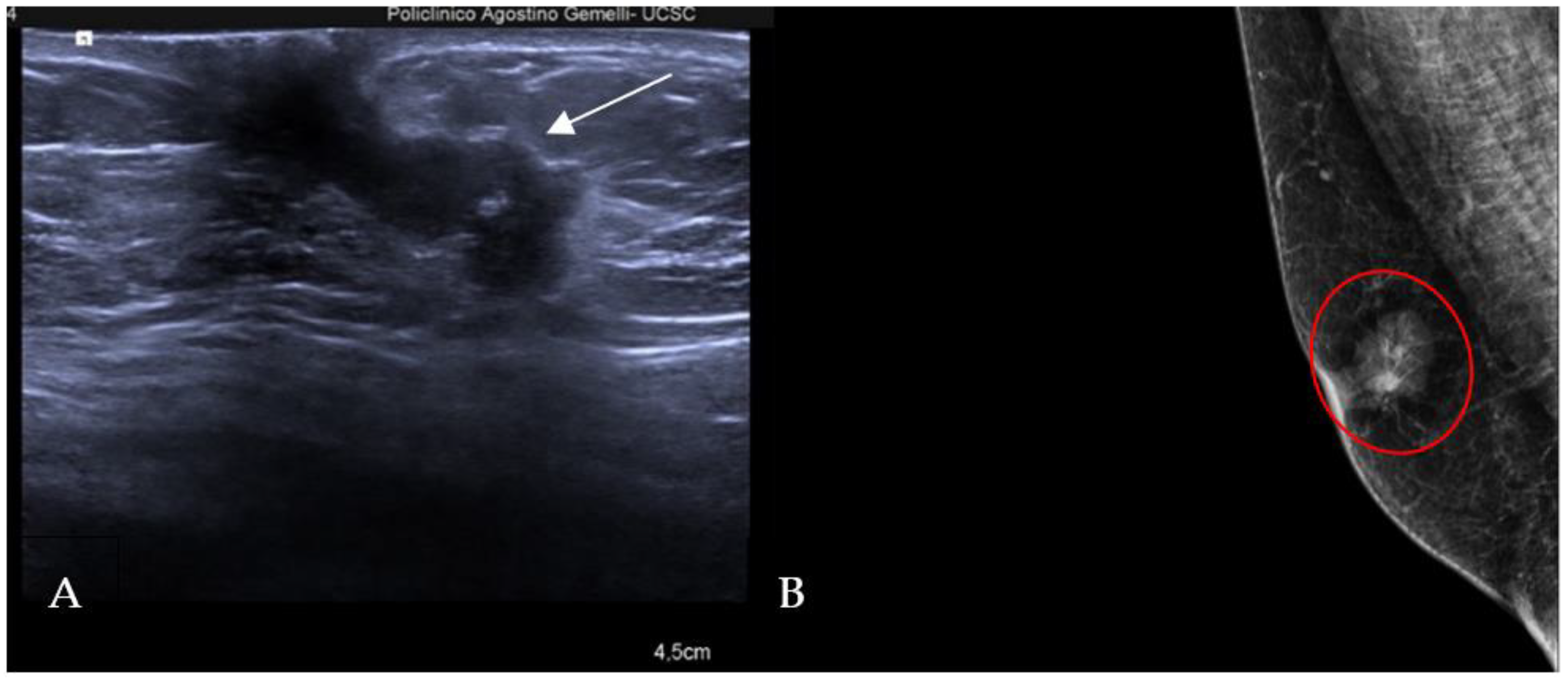


| Benign Non-Neoplastic | Benign Neoplastic | Not Expected |
|---|---|---|
| Gynecomastia Pseudogynecomastia Intramammary Lymph Node Sebaceous Cyst Diabetic Mastopathy Hematoma/Fat Necrosis Abscess Venous Malformation Secondary Syphilis Nodular Fasciitis | Angiomyolipoma Schwannoma Myofibroblastoma Intraductal Papilloma Lipoma Pseudoangiomatous stromal hyperplasia | Lactating adenoma Lobular Carcinoma Fibroepithelial Lesions (Fibroadenoma; Phyllodes tumor & choriocarcinoma) |
| Common Causes of Gynecomastia | |
|---|---|
| Physiologic Causes | Neonatal period or infancy, Puberty, Senescence |
| Drugs | Marijuana, Anabolic Steroids, Leuprolide acetate, Thiazide diuretics, Cimetidine, Tricyclic antidepressants, Estrogen Therapy, Spironolactone, Digitalis |
| Cirrhosis | |
| Hypogonadism | Klinefelter syndrome (XXY); Pituitary hormone deficiency; |
| Neoplasms | Germ cell tumors, Leydig cell tumor, Sertoli cell tumor, Adrenocortical tumors, Pituitary tumors, HCC |
| Hyperthyroidism | |
| Chronic Renal Disease and Dialysis | |
| Idiopathic | |
| Malignant Lesions | ||
|---|---|---|
| Invasive Ductal Carcinoma | Liposarcoma | Basal Cell Carcinoma of the Nipple |
| Invasive Lobular Carcinoma | Dermatofibrosarcoma Protuberans | Metastases |
| Papillary Carcinoma | Pleomorphic hyalinizing angiectatic tumor (PHAT) | |
| Adenoid Cystic Carcinoma | Lymphoma | |
| Primary Tumor | Imaging Findings |
|---|---|
| Melanoma | Multiple and bilateral, well-circumscribed or spiculated breast masses with or without calcifications |
| Lymphoma | Enlarged, hypoechoic, or heterogeneous breast mass |
| Lung Cancer | Multiple nodules or masses with or without calcifications, spiculated margins, and associated pleural or pulmonary abnormalities |
| Prostate Cancer | Unilateral or bilateral solid or cystic breast masses, often located near the nipple or areola |
| Male Patient | Physical Examination | MG | DBT | US | MRI |
|---|---|---|---|---|---|
| Any Age | Gynecomastia | Usually Not Appropriate | Usually Not Appropriate | Usually Not Appropriate | Usually Not Appropriate |
| <25 yo | Indeterminate palpable mass | May be appropriate | May be appropriate | Usually Appropriate | Usually Not Appropriate |
| ≥25 yo | Indeterminate palpable mass | Usually Appropriate | Usually Appropriate | May be appropriate | Usually Not Appropriate |
| ≥25 yo | Indeterminate palpable mass | Suspicious | Suspicious | Usually Appropriate | Usually Not Appropriate |
| Any Age | Suspicious | Usually Appropriate | Usually Appropriate | Usually Appropriate | Usually Not Appropriate |
| Group | Conditions | Physical Examination | Genetic Counseling & Genetic Testing | Breast Self-Examination | Annual MG | Breast MRI |
|---|---|---|---|---|---|---|
| NCCN (2021) [20] | BRCA 1/2 mutation carriers | R | NS | R | R | NR |
| ASCO (2022) [7] | History of BC and BRCA 1/2 mutation carriers | NS | NS | NS | R | NS |
| History of BC | NS | R | NS | R Ipsilateral in case of lumpectomy Contralateral in case of mastectomy | NR | |
| AIOM (2021) [27] | History of BC | R | NS | R | R | NR |
| BRCA 1/2 mutation carriers | NS | NS | NS | R | NR |
Disclaimer/Publisher’s Note: The statements, opinions and data contained in all publications are solely those of the individual author(s) and contributor(s) and not of MDPI and/or the editor(s). MDPI and/or the editor(s) disclaim responsibility for any injury to people or property resulting from any ideas, methods, instructions or products referred to in the content. |
© 2023 by the authors. Licensee MDPI, Basel, Switzerland. This article is an open access article distributed under the terms and conditions of the Creative Commons Attribution (CC BY) license (https://creativecommons.org/licenses/by/4.0/).
Share and Cite
D’Angelo, A.; Portaluri, A.; Caprini, F.; Sofia, C.; Ferrara, F.; Condorelli, E.; Iaccarino, L.; Catanzariti, F.; Mancino, M.; Trombadori, C.M.L.; et al. Male Breast: A Review of the Literature and Current State of the Art of Diagnostic Imaging Work-Up. Diagnostics 2023, 13, 3620. https://doi.org/10.3390/diagnostics13243620
D’Angelo A, Portaluri A, Caprini F, Sofia C, Ferrara F, Condorelli E, Iaccarino L, Catanzariti F, Mancino M, Trombadori CML, et al. Male Breast: A Review of the Literature and Current State of the Art of Diagnostic Imaging Work-Up. Diagnostics. 2023; 13(24):3620. https://doi.org/10.3390/diagnostics13243620
Chicago/Turabian StyleD’Angelo, Anna, Antonio Portaluri, Flavia Caprini, Carmelo Sofia, Francesca Ferrara, Elvira Condorelli, Ludovica Iaccarino, Francesca Catanzariti, Matteo Mancino, Charlotte M. L. Trombadori, and et al. 2023. "Male Breast: A Review of the Literature and Current State of the Art of Diagnostic Imaging Work-Up" Diagnostics 13, no. 24: 3620. https://doi.org/10.3390/diagnostics13243620
APA StyleD’Angelo, A., Portaluri, A., Caprini, F., Sofia, C., Ferrara, F., Condorelli, E., Iaccarino, L., Catanzariti, F., Mancino, M., Trombadori, C. M. L., Belli, P., & Marino, M. A. (2023). Male Breast: A Review of the Literature and Current State of the Art of Diagnostic Imaging Work-Up. Diagnostics, 13(24), 3620. https://doi.org/10.3390/diagnostics13243620







